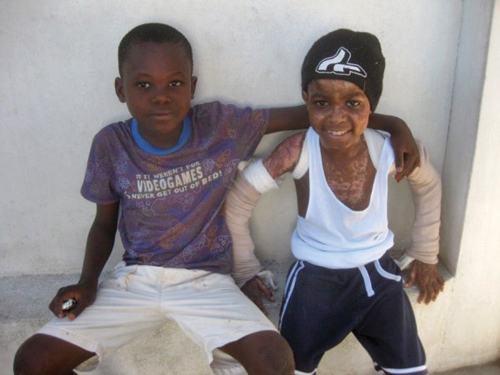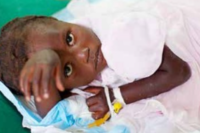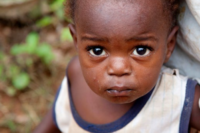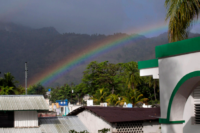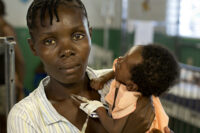Caring for burned patients is a challenge, even in the most advanced burn centers around the world. Infection, wound healing, pain management, nutritional support and physical therapy are all essential components of the healing process requiring caregivers with experience and expertise. In Haiti, these challenges may seem insurmountable.
Burns in Haiti are often a result of common occurrences, such as cooking over open flames, using oil lamps for lighting or house fires from faulty, unreliable electricity. The lack of burn centers, of doctors, nurses and physical therapists that specialize in burn care, and of the supplies and equipment needed to care for these patients, all make caring for burn patients in Haiti very difficult. Many patients with severe burns will die from shock within the first few days, while malnutrition will cause delayed wound healing and result in infection which also causes death. Where do people go when in need of burn care? Who will have the specialists needed to care for them? Thankfully, Hôpital Sacré Coeur in Milot is becoming northern Haiti’s leading burn care center.
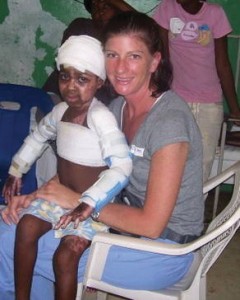 Hôpital Sacré Coeur is a unique hospital managed and staffed by an amazing group of Haitian doctors and nurses, and supplemented by visiting teams of surgeons and nurses from the United States and around the world. These visiting teams come to provide surgical care to patients, and bring with them a wealth of knowledge that they share with the permanent staff. Doctor Jerry Bernard and the other Haitian doctors on staff have been working alongside the visiting surgeons for many years, which has given them the experience needed to care for challenging burn patients. One volunteer spoke for many when she said, “For three months this summer I was fortunate to work alongside Dr. Bernard and his team in caring for a number of burn patients at HSC.”
Hôpital Sacré Coeur is a unique hospital managed and staffed by an amazing group of Haitian doctors and nurses, and supplemented by visiting teams of surgeons and nurses from the United States and around the world. These visiting teams come to provide surgical care to patients, and bring with them a wealth of knowledge that they share with the permanent staff. Doctor Jerry Bernard and the other Haitian doctors on staff have been working alongside the visiting surgeons for many years, which has given them the experience needed to care for challenging burn patients. One volunteer spoke for many when she said, “For three months this summer I was fortunate to work alongside Dr. Bernard and his team in caring for a number of burn patients at HSC.”
One such patient was five-year-old Santos. Santos was burned in March of this year when his family’s home caught fire and the roof collapsed on him. He had full-thickness burns to his head, arms, back and chest. Santos’s burns were severe, and there was worry that he would not survive. Every day Santos would endure painful dressing changes. His wounds were cleaned and an antibiotic cream was applied to help prevent infection. Dr. Bernard and plastic surgeons visiting from the US performed skin grafts on Santos. They took healthy skin from his legs and placed it over the areas where his skin had been burned off.
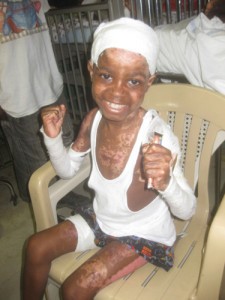 Despite early concerns that Santos would not survive, eventually he began to heal! Doctors used antibiotics to fight off the infections so common with burn patients, while nurses continued to clean his wounds and monitor the new skin that had been applied. Visiting physical therapists worked with Santos to keep his arms and hands moving. Through all of this, Santos was becoming the “Mayor” of HSC; his sweet smile, infectious laugh, love and kindness made him the favorite of the staff. Santos loved to play with the other children in the pediatric unit, and his physical therapy sessions often turned into a party for all the children.
Despite early concerns that Santos would not survive, eventually he began to heal! Doctors used antibiotics to fight off the infections so common with burn patients, while nurses continued to clean his wounds and monitor the new skin that had been applied. Visiting physical therapists worked with Santos to keep his arms and hands moving. Through all of this, Santos was becoming the “Mayor” of HSC; his sweet smile, infectious laugh, love and kindness made him the favorite of the staff. Santos loved to play with the other children in the pediatric unit, and his physical therapy sessions often turned into a party for all the children.
While Santos healed, he developed contractures of the elbows and wrists. Contractures are common when burned skin heals because it shrinks; pulling the arms in and preventing full range of motion. A visiting plastic surgeon from the US was able to release these contractures in all of all the joints involved. This increased Santos’ range of motion and allowed him play, go to school and live a more normal life.
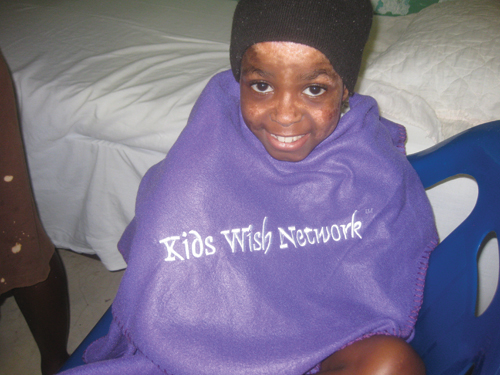 Santos stayed at the hospital for four months to heal and work on the necessary physical therapy. When it was finally time for him to go home, it was at the same time both a very happy and a sad day for those of us who had cared for him at HSC. We were happy that Santos made it through his ordeal and was finally ready to go home with his family to return to his normal life, but we were going to miss the little boy that was a ray of sunshine in all of our days.
Santos stayed at the hospital for four months to heal and work on the necessary physical therapy. When it was finally time for him to go home, it was at the same time both a very happy and a sad day for those of us who had cared for him at HSC. We were happy that Santos made it through his ordeal and was finally ready to go home with his family to return to his normal life, but we were going to miss the little boy that was a ray of sunshine in all of our days.
About a month after Santos was discharged from the hospital. Santos not only had a tremendous impact on HSC staff, he engaged the hearts, minds and skills of those medical volunteers who also joined in his care.
A US medical volunteer reported:
“I had the opportunity to go to Plezance to see him and check on his healing. I was so excited and happy to see that Santos was doing great! His skin was well healed, he could move his arms well, he was able to play, and he was starting school soon. If not for the excellent care he received at HSC, I don’t know if Santos would have survived his injuries, and the surgical care he received for his contractures has given him the ability to use his hands and arms, which will be very important as he grows older.
Another burn patient I cared for was a 28-year-old man named Micheal. Micheal was electrocuted, which had caused his clothes to catch fire. He had burns to 70% of his body, most of which were full-thickness burns. Micheal was very sick when he came to the hospital and his body was in shock. He was admitted to HSC’s ICU with a very high heart rate, low blood pressure, and in need of intensive care.
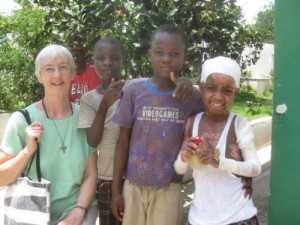 There were a number of times that we thought Micheal might die, as he had terrible infections of his wounds and damage to his heart from the electricity. His wounds required trips to the operating room every day to clean them, remove burned skin, and put on antibiotic cream and new bandages. He was in pain and needed strong pain medicine for his dressing changes. When Micheal had survived the first week, we were all cautiously optimistic because most patients in Haiti with more than 50% of their bodies burned do not survive that long.
There were a number of times that we thought Micheal might die, as he had terrible infections of his wounds and damage to his heart from the electricity. His wounds required trips to the operating room every day to clean them, remove burned skin, and put on antibiotic cream and new bandages. He was in pain and needed strong pain medicine for his dressing changes. When Micheal had survived the first week, we were all cautiously optimistic because most patients in Haiti with more than 50% of their bodies burned do not survive that long.
Though he continued to have serious infections that required IV antibiotics, as the weeks passed, Micheal’s condition improved. When he was finally feeling well enough to begin eating more food, his wounds began to heal. He continued to make daily trips to the operating room for his dressing changes. This was not easy on Micheal; some days he was in good spirits and laughed with the staff, but other days he was very sad and did not want anyone to touch him.
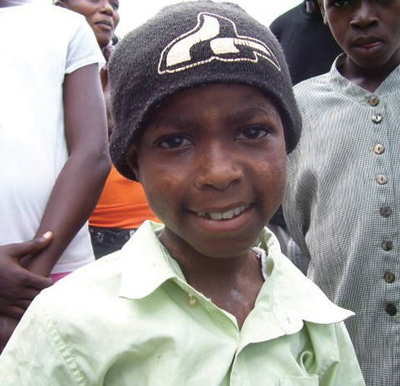 Gradually as his wounds healed, he was able to sit in a chair and go outside, which helped him feel happier! His wife never left his side, and worked with him doing the physical therapy I had taught them. All the hard work and dedication from the staff of Haitian doctors and nurses, as well as the visiting doctors, had begun to pay off. Although he had not yet been discharged when I left Haiti, Micheal was healing and getting stronger everyday!”
Gradually as his wounds healed, he was able to sit in a chair and go outside, which helped him feel happier! His wife never left his side, and worked with him doing the physical therapy I had taught them. All the hard work and dedication from the staff of Haitian doctors and nurses, as well as the visiting doctors, had begun to pay off. Although he had not yet been discharged when I left Haiti, Micheal was healing and getting stronger everyday!”
If Santos and Micheal had not been brought to HSC, their chances of survival would have been very slim. In a country where burn injuries are unfortunately very common, it is essential that there is a hospital like HSC were the staff has the experience to care for burned patients.
HSC is partnering with the Burn Advocates Network to build northern Haiti’s only burn unit. This partnership will provide a new building to house the burn unit, equipment and supplies needed in caring for burn patients, and surgeons, nurses and physical therapists to help care for patients and teach staff.
HSC is very proud of the success we have had in caring for burn patients, and very excited about the future of burn care in Haiti.
“We cared for him during our trip 3/5-11. I never saw him smile.
Abe Houng took care of him the week before us . . . I believe his story was that he had lost his family in the earthquake and was sent to his blind grandmother in the north. She knocked over a kerosene lamp into his bed.
During our week we had to do dressing changes. I was so impressed by the stoicism of this child. So brave and so sad. He broke my heart. He was one of those patients I will never forget. Here’s a note I sent to my friends:
Dear Friends,
Greetings from Milot.
. . . This week a remarkable 5 year-old boy reminded me how the CRUDEM Foundation’s Hôpital Sacré Coeur serves the Lord and His poor every day.
Santos did not cry.
When we approached his bed soon after the morphine, he tried to sit up by himself and then stretched his arms out to each side, knowing what was coming. With a calm acceptance of his fate he gave himself over as Our Lord did when nailed to the cross.
Santos is a beautiful, quiet sad boy whose parents died in the earthquake. Having no family to care for him, he was shipped to his grandmother in Milot. Blind and feeble, it was an accident when she dropped the kerosene lamp, their only source of light on his bed. Santos did not cry as the flames enveloped his arms, his face and chest. 30% third-degree burns may not be a death sentence in the States but it is in Milot. Santos did not cry as he was admitted 10 days ago. The women of Milot attend to his needs. He is still here, traversing the wire between life and death.
Santos did not cry as we soaked his bandages with saline so they would not stick to his skin. He did not cry as we peeled off the gauze. He only shook and whimpered when it was too much to take. Santos did not cry as discussed his care. He did not cry sitting up on the cart as we wheeled him into the OR for his dressing change. He did not cry as Michon put him to sleep and Tammy and Dan began the wound care.
Santos did not cry, but we did. We will carry his image and his tears in our hearts forever.
Bill
We had a lovely nurse anesthetist Michon Coats, who sedated him while Tammy Ostapowicz and Dan Bauman, both OBGYN’s did the dressing changes. Rick Coats, a general surgeon helped the next week, and then Tim O’Connell arrived to do skin grafts. A large cast of volunteers and HSC made extraordinary efforts to care for this child.
William B. Guyol, Jr., MD
St. Louis, MO
“I remember being called back to the hospital after our nightly staff meeting and saw a 5 year old boy with about 30% burns. The history I got was that he was burned from a kerosene lamp. My first reaction was that he might not survive: relatively large surface area and delayed resuscitation. We admitted him into the ICU and started resuscitating him. There were no pediatric central line kits. He was too dry for any peripheral lines, so an IO line was placed. The wounds have a dry dermal wound base on the face and arms and a dessicated base on the upper arm and back. We cleansed his wounds and placed silvadene and xeroform on them. We were doing dressing changes once every 2 days because of limited amount of wound care supplies. Several phone calls and emails went out and Bill was able to bring much needed supplies to Milot when he came.”
Abraham Houng, MD, FACS
Saint Barnabas Medical Center
Department of Surgery
Livingston, New Jersey
“Rereading Dr. Bill’s email and seeing an updated picture of Santos brought a flood of emotions and tears of joy.
I have no pictures and I cannot describe the braveness of this child any better than Bill’s eloquent reflection.
Dressing changes were excruciatingly painful for Santos, as it was for us, who were ill-equipped to deal with the magnitude of his burns, but he showed us all how to endure suffering with a profound and quiet dignity.”
Tammy Ostapowicz. M.D.
OB/GYN
St. Louis, MO
“I took over after Tammy left, had heard about Santos before I arrived and brought supplies for performing skin grafts. We took him to the OR 4 times and were amazed at how well and quickly he healed his wounds. By the time I had left his wounds (except for his hands) were all almost completely healed. I commend Tammy, and her team, for the fantastic work that they did cleaning and debriding his wounds. I know they were working outside of their comfort zone. As has already been said Santos is patient one never forgets. It was a gift to us to be able to care for him.”
Rick Coats, M.D.
General Surgeon
Columbia, MO
We skin grafted the dorsal hands and MP joints to avoid scar contractures and placed his hands in plaster splints last Tuesday; Patrick the prosthetist was gone to the DR and thus we were unable to use light weight plastic material like in the States. The rest of his body is healing nicely from deep 2 degree burns which will not require grafting. The antecubital foossae were spared from 3 degree burns which is a God-send. Dr. Bernard will bring Santos to the OR on Tuesday, March 29 for a dressing change. The splints should be worn one more week to keep the MP joints flexed approx. 90 degrees. Thereafter physical therapy could start with care to avoid tearing the fresh grafts. An ortho team is due to arrive April 2 and could oversee this if they have hand surgery experience. If anyone has questions, ask them to contact me.
Tell everyone they gave Santos excellent care prior to our arrival: we are grateful including Santos who was smiling at the end.
Timothy R. O’Connell, M.D.
Plastic Surgeon
St. Louis, MO


